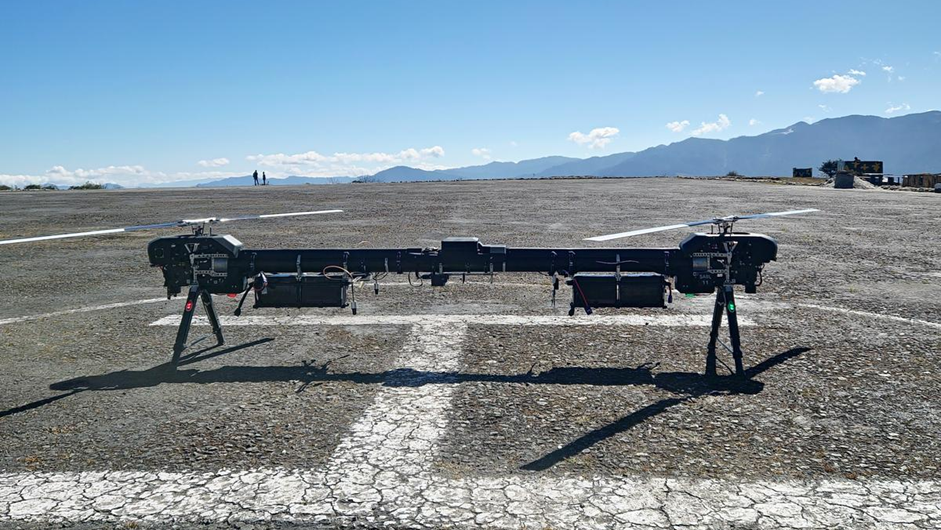- Courses
- GS Full Course 1 Year
- GS Full Course 2 Year
- GS Full Course 3 Year
- GS Full Course Till Selection
- Answer Alpha: Mains 2025 Mentorship
- MEP (Mains Enrichment Programme) Data, Facts
- Essay Target – 150+ Marks
- Online Program
- GS Recorded Course
- Polity
- Geography
- Economy
- Ancient, Medieval and Art & Culture AMAC
- Modern India, Post Independence & World History
- Environment
- Governance
- Science & Technology
- International Relations and Internal Security
- Disaster Management
- Ethics
- NCERT Current Affairs
- Indian Society and Social Issue
- NCERT- Science and Technology
- NCERT - Geography
- NCERT - Ancient History
- NCERT- World History
- NCERT Modern History
- CSAT
- 5 LAYERED ARJUNA Mentorship
- Public Administration Optional
- ABOUT US
- OUR TOPPERS
- TEST SERIES
- FREE STUDY MATERIAL
- VIDEOS
- CONTACT US
Indian Army Receives Sabal 20 Logistics Drone
Indian Army Receives Sabal 20 Logistics Drone
29-11-2024

- In November 2024, The Indian Army received the Sabal 20 logistics drone, which was bought from EndureAir Systems, a company supported by IIT Kanpur.
- This drone is being sent to the Eastern sector of India, an area where the terrain is rough and difficult for regular transport.
Key Features of the Sabal 20 Drone:
- Type: The Sabal 20 is an electric unmanned helicopter. It uses variable pitch technology, which helps control the drone's speed and movement.
- Payload Capacity: The drone can carry up to 20 kg of cargo.
- Design: The drone has a tandem rotor system (two rotors one above the other). This design helps the drone stay stable, especially in high altitudes where the air is thin and conditions are tough.
- Performance: It is designed to work well at high altitudes, making it ideal for areas like the Eastern sector.
- VTOL (Vertical Take-Off and Landing): This allows the drone to take off and land vertically, which makes it useful in small or difficult spaces where traditional aircraft can't land.
- Stealth: The drone’s low RPM (revolutions per minute) design makes it quieter, which helps it stay hidden during sensitive missions.
Uses and Benefits:
- The drone is used for long-distance deliveries, logistical support, and operations in tough terrains where other vehicles might not be able to go.
- The ability to fly in remote areas and small spaces makes it a helpful tool for military missions.
Timeline:
- The tender (request for purchase) for these drones was issued at the end of 2023, and deliveries have just started.
IIT Kanpur Develops Metamaterial Surface Cloaking System (Anālakshya):
- IIT Kanpur has developed a new stealth technology called the Metamaterial Surface Cloaking System (Anālakshya).
- This technology is designed to make objects harder to detect by radar.
Key Features of Anālakshya MSCS:
- Radar Absorption: The system uses a special material that absorbs radar signals, making it difficult for radar to detect the object.
- Stealth Technology: The system helps reduce the radar signature of objects (such as military vehicles or planes), making them harder to see on radar.
- Missile Protection: The system also helps protect against missiles that use radar to guide them by making the target harder to find.
Development Details:
- Creators: The technology was developed by Prof. Anantha Ramakrishna (Physics), Prof. Kumar Vaibhav Srivastava (Electrical Engineering), and Prof. J. Ramkumar (Mechanical Engineering) at IIT Kanpur, with the help of students Gagandeep Singh, Kajal Chowdhary, Abhinav Bhardwaj, and others.
- Testing: The system was tested in labs and in the field from 2019 to 2024, proving that it works well under real-world conditions.
Indigenous Contributions:
- Made in India: About 90% of the materials used in this system are sourced locally, supporting India’s goal to be self-reliant in defense technologies.
- The technology has been licensed to Meta Tattva Systems Pvt. Ltd., a company that will handle the production and deployment of the system.
Impact of These Developments
- Better Defense:
- The Sabal 20 drone will help the Army carry out missions in remote areas where other transport methods cannot go. It makes transporting supplies easier and faster.
- The Anālakshya system will help protect Indian assets by hiding them from radar and making them harder to target by radar-guided missiles.
- Self-Reliance in Defense:
- These technologies show that India is becoming more self-reliant in developing its own defense technologies, reducing the need to depend on other countries for advanced military equipment.
- Broader Use:
- These technologies could also be used for commercial purposes, such as in logistics, surveillance, or security, which could help India grow its tech industry.
Conclusion
The Sabal 20 drone will help the Indian Army carry out logistics and support missions in tough and remote areas. The Anālakshya system is a big step in making military assets invisible to radar and harder to track by missiles.
These developments show how India is advancing in self-reliant defense technologies, improving national security, and pushing for more technological innovation.
Must Check: Best IAS Coaching In Delhi
UPSC Prelims Result 2024 Out: Expected Cut Off & Other Details, UPSC Prelims 2024 Answer with Explanation, Daily Prelims Quiz, Daily Current Affairs, MONTHLY CURRENT AFFAIRS TOTAL (CAT) MAGAZINE, Best IAS Coaching Institute in Karol Bagh, Best IAS Coaching Institute in Delhi, Daily Mains Question Answer Practice, ENSURE IAS UPSC Toppers, UPSC Toppers Marksheet, Previous Year Interview Questions, UPSC Syllabus




